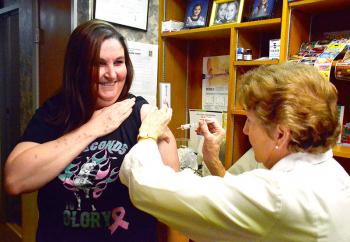
Esther Ryan, L.P.N., is giving Jerri Vaughn a pneumonia vaccine at Dr. Robert Blereau’s office in Morgan City on Tuesday.
(The Daily Review Photo by Crystal Thielepape)
‘Mickey Measles’ prompts precautions
With an outbreak, dubbed “Mickey Measles,” reaching 14 states, the Louisiana Department of Health and Hospitals sent a preventative alert concerning measles to all health care providers, including schools, Tuesday.
Health care providers say the easiest way to avoid measles is to be vaccinated.
The Centers for Disease Control website indicates from Jan. 1 to 30, 102 people in 14 states were reported to have measles. Most of these cases are part of a large, ongoing multi-state outbreak linked to initial exposure in mid-December at Disneyland or Disney California Adventure Park in Anaheim, California.
No outbreaks have been reported in Louisiana. The cases currently are in Arizona, California, Colorado, Illinois, Minnesota, Michigan, Nebraska, New York, Oregon, Pennsylvania, South Dakota, Texas, Utah and Washington
The confirmed cases include five Disney employees. In addition, other cases have visited Disney parks while infectious in January.
Measles is a highly infectious, airborne disease that typically begins with fever, cough, runny nose and red eyes, and within a few days a red rash appears, usually first on the face and then spreading downward to the rest of the body, according to the CDC.
Measles has a 90 percent transmission rate among people who are not immunized or otherwise immune to it.
To maintain herd immunity, communities have to vaccinate enough residents to protect the small number of people who cannot receive a vaccination for medical reasons. Medical experts say that between 92 percent and 95 percent of children should receive two doses of the measles, mumps, and rubella vaccine to maintain herd immunity against measles.
Among Louisiana kindergarteners in the 2013-14 school year, 96.8 percent had received the MMR vaccine, according to CDC reports.
The Louisiana Department of Health and Hospitals reported that St. Mary Parish public school kindergartener vaccination rates during the same school year were 98 percent. Those levels vary among schools with the lowest reporting at 95 percent and six reporting 100 percent.
However, private school kindergarteners in the Houma-Thibodaux Diocese were below the state and federal mandated 95 percent, DHH data indicates.
In the 2012-13 school year, the last with available data, 92 percent of kindergarteners in 10 elementary schools were vaccinated. Among them, Holy Cross Elementary in Morgan City had an 85 percent vaccination rate, the second lowest in the diocese, according to the DHH.
However, the state reported a 97.26 percent immunization rate for non-public school kindergarteners in St. Mary Parish in the 2013-14 school year.
Lydia Duval, St. Mary Parish school nurse facilitator, said, “We encourage parents and families to vaccinate. We also have rules, protocols at the district and state level we have to follow. According to the state, students have to be vaccinated.”
By Louisiana law, measles is to be reported immediately upon suspicion.
According to state alert to health care providers, symptoms of concern are:
—Fever of 101 degrees F or more
—Generalized maculopapular rash (a type of rash characterized by a flat, red area on the skin that is covered with small bumps), usually beginning on the face and spreading to the trunk.
—One or more symptoms: Cough-dry or productive, running nose or conjunctivitis.
Providers are instructed to determine whether the person has traveled within the last 21 days.
If patient presents with any of these symptoms, schools are advised to isolate the patient, practice airborne precautions, refer the student for further testing and report the incident to the state.
The incubation period averages 10 to 12 days, and 14 days from exposure to rash onset.
In 2014, 644 cases of measles were reported in the nation, according to the CDC. One month into the new year, the number of measles cases is nearly one-sixth of last year’s total.
Infected people are usually contagious from about four days before their rash starts to four days afterwards, according to the California Department of Public Health.
Children routinely get their first dose of the measles vaccine at 12 months old or later. The second dose is usually administered before the child begins kindergarten.
Measles vaccines have been available in the United States since 1963, and two doses have been recommended since 1989.
Measles has been eliminated in the United States since 2000. However, large measles outbreaks have occurred in many countries, particularly in Western Europe, Pakistan, Vietnam and the Philippines in recent years. Travelers to areas where measles circulates can bring measles back to the U.S., resulting in limited domestic transmission of measles, the CDC website states.
- Log in to post comments
